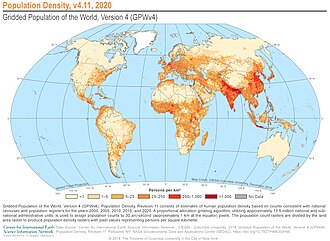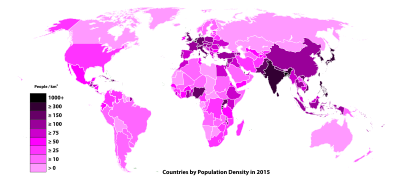Population density
The population density (sometimes also relative population, to differentiate it from the absolute population, which simply equals a certain number of inhabitants in each territory) refers to the average number of inhabitants of a country, region, urban or rural area in relation to a given surface unit of the territory where that country, region or area is located.
Features
F. J. Monkhouse defines it as the average number of inhabitants per surface unit in a given territory. And the Rioduero Geography Dictionary defines it as the average number of inhabitants of a country who live on a surface unit (km²). This number does not accurately reflect reality, since within the same territory there are normally large differences.
Its simple formula is:
Density=PopulationSurface{displaystyle {mbox{Densidad}}={frac {mbox{Poblation}}{mbox{Superficie}}}}}}
Since worldwide the areas of the different nations, regions or administrative divisions are mostly expressed in square kilometers, the density obtained is commonly expressed in inhabitants per km². However, in some countries, for example the United States, the square mile is used more often as a surface unit, so in them the relative population is normally expressed by means of inhab./mi²
Within the same country, urban regions have a higher population density than rural ones. However, in international comparisons this may not always be the case. For example, some rural areas of the overcrowded Indonesian island of Java (which in turn has an absolute population of about 150 million inhabitants and a relative population of about 1,170 inhab./km² on average) have a higher density than some urbanized regions of Europe, above all, if we compare some urban regions with part of its sparsely populated territory, with extensive rural regions of high density.
The most densely populated countries or territories in the world are also usually quite small and, in some cases, city-states. Among them are Macao (a special administrative region of China), Singapore, Hong Kong (another Chinese SAR), the Gaza Strip (one of the two Palestinian regions) or the small European principality of Monaco. On the other hand, among the nations with the largest absolute population, Bangladesh, India and Japan stand out for their density. In Latin America, Puerto Rico, El Salvador (the most densely populated nation on the Central American isthmus), Guatemala and Cuba stand out.
The city with the highest population density in the world is Kowloon, in Hong Kong (China) with a population of 50,000 and an area of 0.026 km² (density of 1,923,077 inhab/km² in 2006), followed by Macao, also in China.
Until 1993, when it was demolished, there existed within Kowloon what became known as the Kowloon Walled City, which in only 0.026 km² had a population of 50,000 inhabitants, which meant a density of almost 2 million inhabitants per km². However, the context in which this case occurred generated extreme overcrowding and pushed the habitability conditions of the homes to the limit.
In a general sense, it can be said that the greater and greater population densities of the big cities of the world present problems that are different and even opposite to those of the rural areas of emigration. If typical urban problems (housing, transportation, sources of employment, urban services, citizen security, marginalization, etc.) become more acute in cities, in rural areas economic development or infrastructure projects cannot be developed for lack or shortage of manpower. In a book by Ester Boserup it is pointed out that with the increase in population and agricultural production, the concentration of the population in urban centers is practically inevitable. Boserup also points out that technological change in agriculture occurs when the population density rate reaches a critical point, which not only increases demographic concentration in cities, but also modifies the situation in the countryside with the technical development, increased production and, above all, the diversification of the economy, with the start and growth of industrial and service companies. The difference between the two options marks a process of change worldwide that has been taking place in the past 100 to 150 years: the decrease in the peasant population due to the rural exodus forces the remaining farmers to acquire more land (those of emigrants) who will have to put to work with the use of a greater number of machines (increase in capital) and above all, they also force them to change the types of crops that allow them greater productivity and a higher yield per hectare. high.
Countries with the lowest population density
Just as there are places that have high population densities, there are countries in which the density is much lower. It can be for different reasons such as the climate: in Antarctica, the only population is scientists or tourists who temporarily reside (for health reasons), the population density is less than one inhabitant per square kilometer (km²), as well as in Western Sahara, whose population density is 1.15 inhabitants per square kilometer (although the figure is irrelevant, since the majority of the population resides outside the country). One of the problems can also be the scarcity of resources (jobs, labor, food, etc.) and in Australia, where the population density is 3 inhabitants per square kilometer. In 2018, the five countries with the lowest population density were the following:
- Mongolia, with 2 rooms/km2.
- Australia, with 3 rooms/km2.
- Iceland, with 3 rooms/km2.
- Namibia, with 3 rooms/km2.
- Libya, with 4 inhabitants/km2.
The autonomous region of Greenland has a density of 0.026 inhab/km².
Contenido relacionado
Sorihuela
Navamorales
Mozárbez




